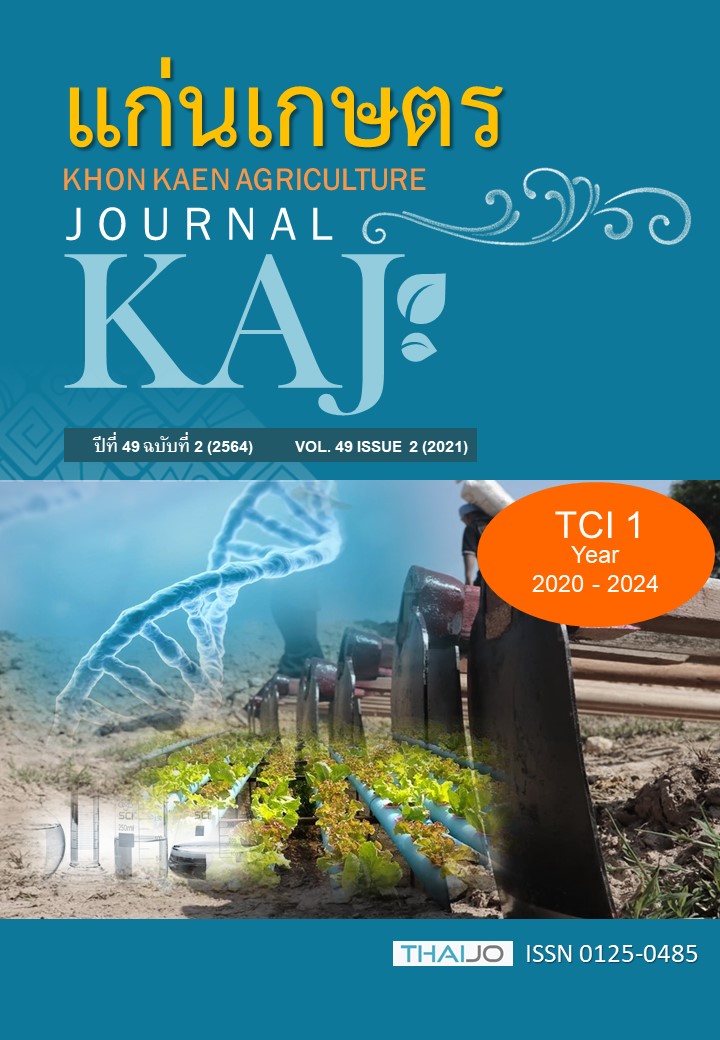อิทธิพลของระดับสายเลือดต่อการเจริญเติบโต, องค์ประกอบซาก, ปริมาณไขมันแทรกในกล้ามเนื้อและองค์ประกอบกรดไขมันในไก่ลูกผสมพื้นเมืองไทย
Main Article Content
บทคัดย่อ
ไก่พื้นเมืองไทยมีวิวัฒนาการสามารถปรับตัวภายใต้สภาพภูมิอากาศร้อนชื้น และเนื่องจากเอกลักษณ์ของเนื้อและคุณภาพเนื้อที่ดีของไก่พื้นเมืองไทยทำให้เป็นที่ต้องการของผู้บริโภค แต่อย่างไรก็ตามเนื่องจากไก่พื้นเมืองไทยสายพันธุ์แท้มีการเจริญเติบโตช้าทั่วไปจึงนิยมใช้การผสมข้ามพันธุ์เพื่อปรับปรุงพันธุ์ แต่เนื่องจากการผสมข้ามดังกล่าวส่งผลต่อลักษณะองค์ประกอบซากรวมถึงด้านปริมาณและคุณภาพของการสะสมไขมัน ดังนั้นการศึกษาครั้งนี้จึงมีจุดประสงค์เพื่อตรวจสอบอิทธิพลของระดับสายเลือดพื้นเมืองไทยต่อลักษณะดังกล่าวโดยศึกษาในไก่ 4 สายพันธุ์ประกอบด้วยสายไก่พื้นเมืองพันธุ์แท้พันธุ์ชี (CH), ไข่มุกอีสาน 1 (KM1) (ระดับสายเลือดพื้นเมือง 50%), ไข่มุกอีสาน 2 (KM2) (ระดับสายเลือดพื้นเมือง 25%) และไก่เนื้อ (BR) โดยกำหนดทรีทเมนต์เป็นสายพันธุ์ สายพันธุ์ละ 100 ตัวแบบคละเพศ แบ่งออกเป็น 4 ซ้ำ ซ้ำละ 25 ตัว ผลการศึกษาพบว่าน้ำหนักตัวของสายพันธุ์ BR สูงกว่า KM2, KM1 และ CH ตามลำดับ เช่นเดียวกันกับสัดส่วนเนื้ออกพบว่า BR และ KM2 มีค่าสูงกว่า (P<0.01) KM1 และ CH การศึกษานี้ไม่พบความแตกต่างระหว่างเปอร์เซ็นต์ไขมันในกล้ามเนื้อระหว่างไก่ลูกผสมสายพันธุ์ KM1 และ KM2 การศึกษาองค์ประกอบกรดไขมันพบว่า กรดไขมันไม่อิ่มตัวเชิงซ้อน (PUFA) และ กรดไขมัน omega-6 ของสายพันธุ์ CH มีค่าสูงกว่า (P<0.01) ในขณะที่ BR และ KM2 มีค่า MUFA สูงกว่า (P<0.01) ซึ่งการทำงานของเอนไซม์ △9desaturase ในสายพันธุ์ BR และ KM2 มีการทำงานสูงกว่า (P <0.01) KM1 และ CH แต่การทำงานของเอนไซม์△5 และ△6 ของสายพันธุ์ CH มีการทำงานสูงกว่า (P<0.01) จึงสรุปได้ว่าการผสมข้ามพันธุ์ส่งผลต่อการเปลี่ยนแปลงองค์ประกอบของกรดไขมันโดยการแทนที่ PUFA ด้วย MUFA ผ่านการควบคุมการทำงานของเอนไซม์ desaturase ทำให้สูญเสียกรดไขมันที่จำเป็นซึ่งเป็นที่นิยมของผู้บริโภคเช่น PUFA
Article Details

อนุญาตภายใต้เงื่อนไข Creative Commons Attribution-NonCommercial-NoDerivatives 4.0 International License.
เอกสารอ้างอิง
สัญชัย จตุรสิทธา. 2550. การจัดการเนื้อสัตว์. พิมพ์ครั้งที่ 4. โรงพิมพ์มิ่งเมือง, เชียงใหม่.
AOAC. 1995. Official Methods of Analysis. 16th Edition. Association of Official Analytical Chemists, Arlington, VA.
Ahmed, I., Z. Li, X. Duan, D. Gu, T. Dou, Y. Huang, C. Ge, X. Zhang, and J. Jia. 2019. Correlative analysis of lipid contents and gene expression between chicken breeds. Pakistan Journal of Agricultural Sciences. 56(4): 1095-1105.
Boschetti, E., A. Bordoni, A. Meluzzi, C. Castellini, A. D. Bosco, and F. Sirri. 2016. Fatty acid composition of chicken breast meat is dependent on genotype-related variation of FADS1 and FADS2 gene expression and desaturating activity. Animal. 10: 700–708.
Chabault, M., E. Baéza, V. Gigaud, P. Chartrin, H. Chapuis, M. Boulay, C. Arnould, F. D’Abbadie, C. Berri, and E. Le Bihan-Duval. 2012. Analysis of a slow-growing line reveals wide genetic variability of carcass and meat quality-related traits. BMC Genetics. 13(1): 90-98.
Dal Bosco, A., C. Mugnai, S. Ruggeri, S. Mattioli, and C. Castellini. 2012. Fatty acid composition of meat and estimated indices of lipid metabolism in different poultry genotypes reared under organic system. Poultry Science. 91: 2039–2045.
Folch, J., M. Lees, and G. H. Sloane Stanley. 1957. A simple method for the isolation and purification of total lipides from animal tissues. Journal of Biological Chemistry. 226: 497–509.
Hocquette, J. F., F. Gondret, E. Baéza, F. Médale, C. Jurie, and D. W. Pethick. 2010. Intramuscular fat content in meat-producing animals: development, genetic and nutritional control, and identification of putative markers. Animal. 4: 303–319.
Jaturasitha, S., N. Chaiwang, and M. Kreuzer. 2017. Thai native chicken meat: an option to meet the demands for specific meat quality by certain groups of consumers; a review. Animal Production Science. 57(8): 1582-1587.
Jaturasitha, S., A. Kayan, and M. WICKE. 2008a. Carcass and meat characteristics of male chickens between Thai indigenous compared with improved layer breeds and their crossbred. Archiv fur Tierzucht. 51: 283-294.
Jaturasitha, S., T. Srikanchai, M. Kreuzer, and M. Wicke. 2008b. Differences in Carcass and Meat Characteristics Between Chicken Indigenous to Northern Thailand (Black-Boned and Thai Native) and Imported Extensive Breeds (Bresse and Rhode Island Red). Poultry Science. 87: 160–169.
Jayasena, D. D., S. Jung, A. U. Alahakoon, K. C. Nam, J. H. Lee, and C. Jo. 2015. Bioactive and Taste-related Compounds in Defatted Freeze-dried Chicken Soup Made from Two Different Chicken Breeds Obtained at Retail. The Journal of Poultry Science. 52: 156–165.
Khan, U., J. Hussain, A. Mahmud, A. Khalique, S. Mehmood, I. H. Badar, M. Usman, M. H. Jaspal, and S. Ahmad. 2019. Comparative Study on Carcass Traits, Meat Quality and Taste in Broiler, Broiler Breeder and Aseel Chickens. Brazilian Journal of Poultry Science. 21(1): 001-010.
Kris-Etherton, P. M., A. E. Griel, T. L. Psota, S. K. Gebauer, J. Zhang, and T. D. Etherton. 2005. Dietary stearic acid and risk of cardiovascular disease: intake, digestion, and absorption. Lipids. 40: 1193–1200.
Le Bihan-Duval, E., N. Millet, and H. Remignon. 1999. Broiler meat quality: effect of selection for increased carcass quality and estimates of genetic parameters. Poultry Science. 78: 822–826.
Malau-Aduli, A. E., B. D. Siebert, C. D. Bottema, and W. S. Pitchford. 1998. Breed comparison of the fatty acid composition of muscle phospholipids in Jersey and Limousin cattle. Journal of Animal Science. 76(3): 766-773.
Padhi, M. K. 2016. Importance of indigenous breeds of chicken for rural economy and their improvements for higher production performance. Scientifica. 2016: 001–009.
Rymer, C., and D. I. Givens. 2006. Effect of species and genotype on the efficiency of enrichment of poultry meat with n-3 polyunsaturated fatty acids. Lipids. 41: 445–451.
SAS Institute 1988. Guide for personal computers, Version 6.03. SAS Institute Inc., Cary, NC, USA
Tang, H., Y. zhi Gong, C. X. Wu, J. Jiang, Y. Wang, and K. feng Li. 2009. Variation of meat quality traits among five genotypes of chicken. Poultry Science. 88(10): 2212-2218.
Wattanachant, S., S. Benjakul, and D. A. Ledward. 2005. Effect of heat treatment on changes in texture, structure and properties of Thai indigenous chicken muscle. Food Chemistry. 93: 337–348.
Yin, H. D., E. R. Gilbert, S. Y. Chen, Y. Wang, Z. C. Zhang, X. L. Zhao, Y. Zhang, and Q. Zhu. 2013. Effect of Hybridization on Carcass Traits and Meat Quality of Erlang Mountainous Chickens. Asian-Australasian Journal of Animal Science. 26: 1504–1510.
Yu, S., J. Derr, T. D. Etherton, and P. M. Kris-Etherton. 1995. Plasma cholesterol-predictive equations demonstrate that stearic acid is neutral and monounsaturated fatty acids are hypocholesterolemic. The American Journal of Clinical Nutrition. 61: 1129–1139.
Zerehdaran, S., A. L. J. Vereijken, J. A. M. van Arendonk, and E. H. van der Waaijt. 2004. Estimation of genetic parameters for fat deposition and carcass traits in broilers. Poultry Science. 83: 521–525.
Zhao, G. P., J. L. Chen, M. Q. Zheng, J. Wen, and Y. Zhang. 2007. Correlated responses to selection for increased intramuscular fat in a Chinese quality chicken line. Poultry Science. 86: 2309–2314.


